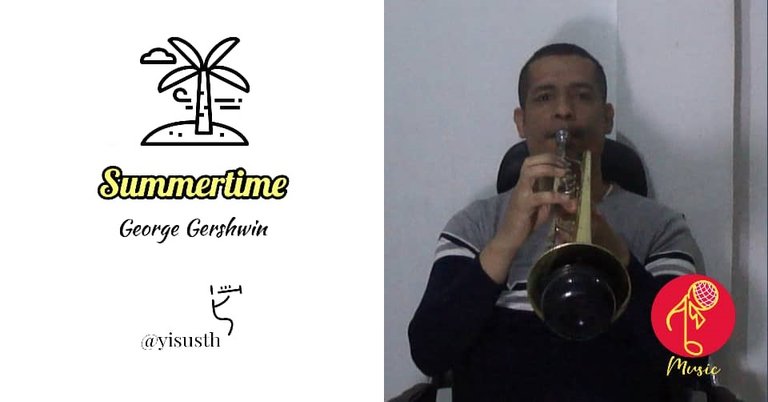
A charming and memorable melody is that of «Summertime», a classic jazz piece composed by George Gershwin, with the collaboration of DuBose Heyward, Dorothy Heyward and Ira Gershwin. It is part of an opera aria from the 1935 play Porgy and Bess. The lyrics are full of beautiful images, such as "fish have to swim and birds have to fly" and "cotton fields fluttering in the summer sun." ". I have had the opportunity to listen to covers by Ella Fitzgerald, Louis Armstrong and Billie Holiday. The song is in the key of A minor, which gives it a melancholic and nostalgic air despite the summer theme. The harmonic progression is based mainly on the chords I (A minor), IV (D minor) and V7 (E7 dominant). However, there are some interesting chromaticisms that add a touch of sophistication, such as the use of an augmented chord in the second half of the verse. There is a subtle use of syncopation and blue notes that give a jazzy flavor to the melody. The rhythm of the song is relaxed and balanced, with a moderate tempo of 4/4. I love the use of irregular triplets that gives it a touch of swing and dynamism.
Spanish | Español (click here)
Una melodía encantadora y memorable es la de «Summertime», una pieza clásica de Jazz compuesta por George Gershwin, con la colaboración de DuBose Heyward, Dorothy Heyward e Ira Gershwin. Es parte del aria de una ópera de la obra Porgy y Bess, de 1935. La letra está llena de bellas imágenes, como "los peces tienen que nadar y los pájaros tienen que volar" y "campos de algodón ondeando bajo el sol de verano". He tenido la oportunidad de escuchar versiones de Ella Fitzgerald, Louis Armstrong y Billie Holiday. La canción está en clave de La menor, lo que le da un aire melancólico y nostálgico a pesar de la temática veraniega. La progresión armónica es basada principalmente en los acordes I (La menor), IV (Re menor) y V7 (Mi7 dominante). Sin embargo, hay algunos cromatismos interesantes que añaden un toque de sofisticación, como el uso de un acorde aumentado en la segunda mitad del verso. Hay un uso sutil de síncopas y notas azules que le dan un sabor a jazz a la melodía. El ritmo de la canción es relajado y balanceado, con un tempo moderado de 4/4. Me encanta el uso de tresillos irregulares que le da un toque de swing y dinámismo.

Ear training is a fundamental tool for musicians of any level and instrument. As a music teacher I focus on my students developing the ability to listen to and understand the different elements of music. That is why I recommend listening to music abundantly, especially that which has a richness of sound and rhythms. Ear training helps identify and correct tuning errors, both in the voice and the instrument. One of the most important exercises is listening to and playing intervals, scales, chords and melodies. One of the exercises that I loved to do in music school is melodic rhythmic dictation. Without auditory training it is difficult to write a musical dictation. The exercise consisted of the teacher playing a rhythmic melody on the piano, the student listening to it and writing it on the staff. The phrase was repeated up to three times. Now, I understand that not all people who sing read sheet music, but a good exercise is to listen to a melody, then record yourself playing it back with your voice or instrument. Then you will notice if you are in the right tone. It is important not to give up and strive to practice being patient with yourself.
Spanish | Español (click here)
El entrenamiento auditivo es una herramienta fundamental para los músicos de cualquier nivel e instrumento. Como profesor de música me enfoco en que mis estudiantes puedan desarrollar la capacidad de escuchar y comprender los diferentes elementos de la música. Es por eso por lo que recomiendo escuchar música abundantemente, sobre toda aquella que tiene una riqueza sonora y de ritmos. El entrenamiento auditivo ayuda a identificar y corregir errores de afinación, tanto en la voz como en el instrumento. Uno de los ejercicios más importantes es el escuchar y reproducir intervalos, escalas, acordes y melodías. Uno de los ejercicios que me encantaba realizar en la escuela de música es el dictado rítmico melódico. Sin entrenamiento auditivo difícilmente se puede escribir un dictado musical. El ejercicio consistía en que el maestro interpreta una melodía rítmica en el piano, el estudiante la escucha y la escribe en el pentagrama. La frase se repetía hasta tres veces. Ahora, entiendo que no todas las personas que cantan leen una partitura, pero un buen ejercicio es escuchar una melodía, luego grabarse al reproducirla con la voz o el instrumento. Entonces notarás si estas en el tono correcto. Es importante no rendirse y esforzarse por practicar siendo paciente consigo mismo.

Summertime
Summertime
And the livin' is easy
Fish are jumpin'
And the cotton is high
Oh, your daddy's rich
And your ma is good-lookin'
So hush, little baby
Don't you cry
One of these mornings
You're going to rise up singing
Then you'll spread your wings
And you'll take the sky
But 'til that morning
There's a'nothing can harm you
With daddy and mammy standing by
[Instrumental]
One of these mornings
You're going to rise up singing
Then you'll spread your wings
And you'll take the sky
But 'til that morning
There's a'nothing can harm you
With daddy and mammy standing by
Fuentes / Sources
| Images | Obtained in Unsplash |
|---|---|
| Lyrics | “Summertime” by George Gershwin on Genius |
| Thumbnail & Banner | Made with Adobe Creative Cloud Express |
| Gifs | Created with EZGif |
| Specific information | ENO |
▶️ 3Speak


